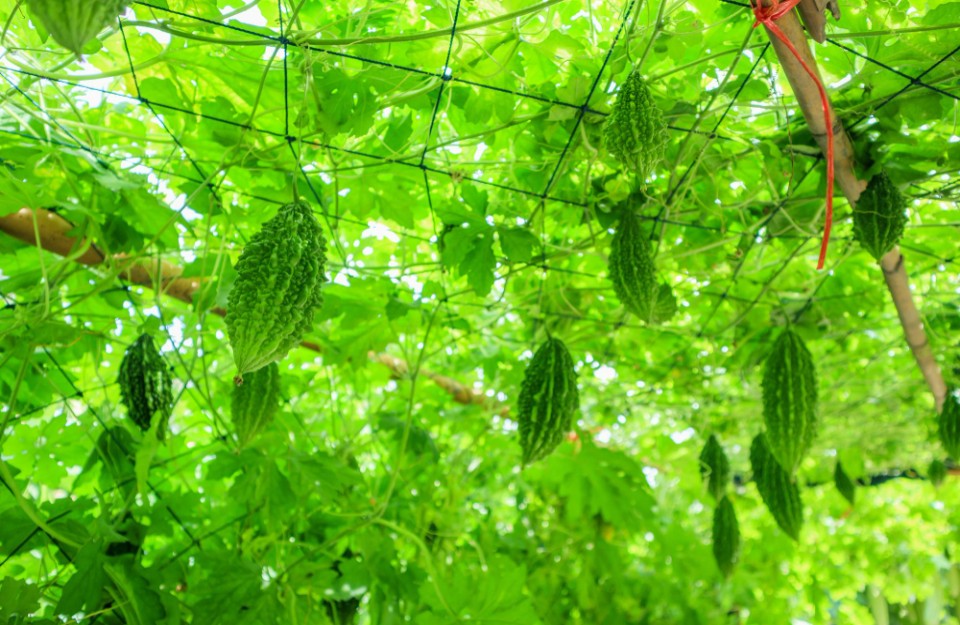
Bitter gourd is among the popular vegetables, with its fruit being used as a vegetable for thousands of years. It is extensively cultivated in tropical and subtropical regions worldwide. Often referred to as 'bitter melon' or 'unpleasant gourd,' its taste is notably bitter throughout the plant, including its natural products. This crop possesses anti-diabetic and anti-cancer properties, contributing to its high nutritional and medicinal value. Consequently, it is witnessing a growing demand.
Bitter gourd cultivation occurs from January to February in the summer season, while the crop is planted in May during the rainy season. In hilly regions, seeds are sown from April to July. For one hectare, 4-5 kilograms of seeds are necessary. Prior to sowing, the seeds undergo treatment with Thiram (3 grams/kilogram of seeds). Germination takes a longer duration at lower temperatures. Seed germination thrives optimally at 25 - 35°C. Four seeds are placed per pit initially, with 2-3 seedlings later retained per pit.
The land is readied for bitter gourd cultivation through thorough plowing and leveling with 1-2 crosswise plowings to achieve a fine soil structure with small particles. The field remains open. The field is dug to a depth of 30 centimeters, ensuring a fine soil structure with small particles, and the hills should be shaped in dimensions of 30 meters x 30 x 30 meters, filled with compost and surface soil.
Given its weak climbing nature, bitter gourd necessitates support for optimal growth. With support, bitter gourd plants can yield for 6-7 months, whereas those grown without support on the ground typically yield for only 3-4 months. This method reduces susceptibility to pests and diseases as the vines avoid direct contact with the soil. In a trellis system, planting is spaced at 2.5 x 1 meters. Furrows are established with 2.5 meters between them, and irrigation channels are situated at intervals of 5-6 meters. Seeds are dibbled along the furrow at 1-meter intervals and lightly covered with soil. Vines usually take 1.5-2 months to reach the trellis height. Hence, during initial growth stages, vines are guided using ropes until they reach the trellis. Once vines reach the trellis height, new tendrils are directed onto the trellis for support.
Bitter gourd flourishes in arid and well-drained soil, particularly in medium loamy soil with ample organic content. Soil from riverbanks is also conducive to bitter gourd cultivation. An optimal pH range of 6.5-7.5 is recommended. This crop thrives in warm climates and is predominantly cultivated in subtropical regions. The ideal temperature range for growth falls between 24-27°C. Seed germination is most successful at temperatures exceeding 18°C. Ensuring proper soil moisture is crucial for agricultural yield. Excessive waterlogging can adversely affect crop health.
Cultivating hybrid bitter gourd requires well-drained soil with a pH range of 6.5-7.5, rich in loamy soil. Hybrid bitter gourd plants grow rapidly, yielding larger fruits compared to traditional varieties, albeit with a slightly inferior taste. Fruits from plants grown from hybrid seeds mature quickly.
Characteristics and Uses of Bitter Gourd: Bitter gourd serves as an antioxidant, aiding in the reduction of hypoglycemic blood sugar levels. It boasts antimicrobial properties and anti-cancer capabilities. The phenolic compounds present in bitter gourd contribute to lowering the risk of high blood pressure, cholesterol, heart disease, and cancer. Additionally, it can function as a dietary supplement to help prevent the development of breast cancer. Bitter gourd contains various active proteins and steroids in its leaves, stems, seeds, and fruits, which show potential effectiveness in combating cancer. Extracts from bitter gourd serve as insulin, regulating insulin release and influencing glucose metabolism. This makes it valuable in treating serious conditions like diabetes. Moreover, it aids in reducing low immune resistance, hormonal deficiencies, and collagen synthesis, which are advantageous for managing diabetes.
Nursery Management: A nursery can be established using sand trays or beds. Seeds can be directly sown in the nursery, ensuring adequate water and sunlight for proper growth. Plants can be transferred directly from the nursery to the field within 10 days. If additional time is required, plants can be moved to pots for up to two more weeks.
Pest and Disease Management: